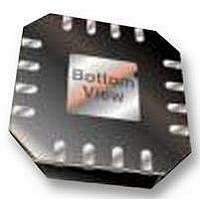AD7143ACPZ Analog Devices Inc, AD7143ACPZ Datasheet - Page 11

AD7143ACPZ
Manufacturer Part Number
AD7143ACPZ
Description
IC, CDC, 16BIT, SMD, LFCSP-16, 7143
Manufacturer
Analog Devices Inc
Datasheet
1.AD7143ACPZ.pdf
(56 pages)
Specifications of AD7143ACPZ
Supply Voltage Range
2.6V To 3.6V
Operating Temperature Range
-40°C To +85°C
Digital Ic Case Style
LFCSP
No. Of Pins
16
Svhc
No SVHC (18-Jun-2010)
Package / Case
LFCSP
Base Number
7143
Ic Function
Programmable Controller For Capacitance Touch Sensors
Rohs Compliant
Yes
Lead Free Status / RoHS Status
Lead free / RoHS Compliant
Available stocks
Company
Part Number
Manufacturer
Quantity
Price
Part Number:
AD7143ACPZ-1
Manufacturer:
ADI/亚德诺
Quantity:
20 000
Company:
Part Number:
AD7143ACPZ-1500RL7
Manufacturer:
NSC
Quantity:
654
Part Number:
AD7143ACPZ-1500RL7
Manufacturer:
ADI/亚德诺
Quantity:
20 000
THEORY OF OPERATION
The AD7143 is a capacitance-to-digital converter (CDC) with
on-chip environmental compensation, intended for use in
portable systems requiring high resolution user input. The
internal circuitry consists of a 16-bit, ∑-Δ converter that
converts a capacitive input signal into a digital value. There are
eight input pins, CIN0 to CIN7, on the AD7143. A switch
matrix routes the input signals to the CDC. The result of each
capacitance-to-digital conversion is stored in on-chip registers.
The host subsequently reads the results over the serial interface.
The AD7143 has an I
compatible with a wide range of host processors.
The AD7143 interfaces with up to eight external capacitance
sensors. These sensors can be arranged as buttons, scroll bars,
wheels, or as a combination of sensor types. The external
sensors consist of electrodes on a single or multiple layer PCB
that interface directly to the AD7143.
The AD7143 can be set up to implement any set of input
sensors by programming the on-chip registers. The registers can
also be programmed to control features such as averaging,
offsets, and gains for each of the external sensors. There is a
sequencer on-chip to control how each of the capacitance
inputs is polled.
The AD7143 has on-chip digital logic and 528 words of RAM
used for environmental compensation. The effects of humidity,
temperature, and other environmental factors can effect the
operation of capacitance sensors. Transparent to the user, the
AD7143 performs continuous calibration to compensate for
these effects, allowing the AD7143 to give error-free results at
all times.
The AD7143 requires some minor companion software that
runs on the host or other microcontroller to implement high
resolution sensor functions, such as a scroll bar or wheel.
However, no host software is required to implement buttons,
including 8-way button functionality. Button sensors are
implemented completely in digital logic on-chip with the status
of each button reported in interrupt status registers.
The AD7143 can be programmed to operate in either full power
mode, or in low power automatic wake-up mode. The
automatic wake-up mode is particularly suited for portable
devices that require low power operation giving the user
significant power savings coupled with full functionality.
The AD7143 has an interrupt output, INT , to indicate when
new data has been placed into the registers. INT is used to
interrupt the host on sensor activation.
2
C interface, ensuring that the parts are
Rev. 0 | Page 11 of 56
The AD7143 operates from a 2.6 V to 3.6 V supply, and is
available in a 16-lead, 4 mm × 4 mm LFCSP_VQ.
CAPACITANCE SENSING THEORY
The AD7143 uses a method of sensing capacitance known as
the shunt method. Using this method, an excitation source is
connected to a transmitter generating an electric field to a
receiver. The field lines measured at the receiver are translated
into the digital domain by a ∑-Δ converter. When a finger, or
other grounded object, interferes with the electric field, some of
the field lines are shunted to ground and do not reach the
receiver (see Figure 17). Therefore, the total capacitance
measured at the receiver decreases when an object comes close
to the induced field.
In practice, the excitation source and ∑-Δ ADC are implemented
on the AD7143, while the transmitter and receiver are constructed
on a PCB that comprises the external sensor.
Registering a Sensor Activation
When a sensor is approached, the total capacitance associated
with that sensor, measured by the AD7143, changes. When the
capacitance changes to such an extent that a set threshold is
exceeded, the AD7143 registers this as a sensor touch and then
automatically updates the internal interrupt status registers.
Preprogrammed threshold levels are used to determine if a
change in capacitance is due to a button being activated. If the
capacitance exceeds one of the threshold limits, the AD7143
registers this as a true button activation. The same threshold
principle is used to determine if other types of sensors, such as
sliders or scroll wheels, are activated.
AD7143
Figure 17. Single Layer Sensing Capacitance Method
Rx
ADC
Σ-Δ
PCB LAYER
16-BIT
DATA
Tx
PLASTIC COVER
EXCITATION
SIGNAL
250kHz
AD7143













